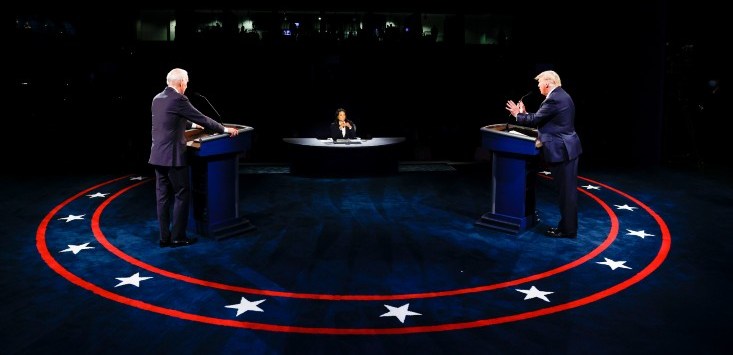
Donald Trump and Joe Biden during the US Presidential Debate. Source: EPA.
In the wake of 2020’s historic US presidential election, it looks like yet another occupation is set for robot takeover: that of the pollster.
After famously missing the mark on the UK’s Brexit vote and the 2016 presidential race, the traditional polls didn’t get the outcome entirely wrong this time around.
But they did have a much bigger margin than what actually eventuated. And their predictions were reportedly even further out than they were four years ago.
Meanwhile, someone — or something, at least — was right on the money.
Back in October, Italian artificial intelligence company Expert.ai projected Joe Biden would win 50.2% of the popular vote and Donald Trump would get 47.3%. At that time, national polls had Biden’s percentage-point lead in the double-digits.
Fast forward a few weeks, and at the time of writing, with 94% of the vote counted, Biden has 50.7% of the popular vote, and Trump has 47.7%.
Expert.ai used ‘sentiment analysis’ and natural language processing to assess the emotions behind social media posts.
While Trump was the subject of much more social media activity, Biden-focused posts ranked higher in terms of positive emotions.
According to Fortune, the same tech correctly predicted the UK’s exit from the European Union.
Elsewhere, US ‘swarm technology’ startup Unanimous.ai used pioneering tech to predict which way some of the key battleground states would swing.
Headed up by founder and chief Dr Louis Rosenberg, Unanimous.ai uses AI and machine learning models to aggregate predictions and decisions from relatively small groups of people.
According to The Wall Street Journal, a live survey of just 50 people, back in September, asked participants to predict who would win in 11 key states, and by what margin.
The live survey allows users to see what other participants are predicting, in real time.
Machine learning algorithms then learn who is most confident in their assertions, based on whether they change their mind or not.
The most confident responses have the most influence on the final predictions.
By the Sunday afternoon after polls opened, those predictions had come correct in 10 of the 11 states, and the 11th was yet to declare.
“Our data was 50 randomly selected voters and then the use of a swarm to amplify their intelligence; it wasn’t 100,000 poll samples,” Rosenberg told the Wall Street Journal.
“Again and again, we see that we’re able to outperform really huge polls.”
Handpicked for you

Aussie AI startup bags $700,000 to take pioneering sewer-repair tech global



COMMENTS
SmartCompany is committed to hosting lively discussions. Help us keep the conversation useful, interesting and welcoming. We aim to publish comments quickly in the interest of promoting robust conversation, but we’re a small team and we deploy filters to protect against legal risk. Occasionally your comment may be held up while it is being reviewed, but we’re working as fast as we can to keep the conversation rolling.
The SmartCompany comment section is members-only content. Please subscribe to leave a comment.
The SmartCompany comment section is members-only content. Please login to leave a comment.